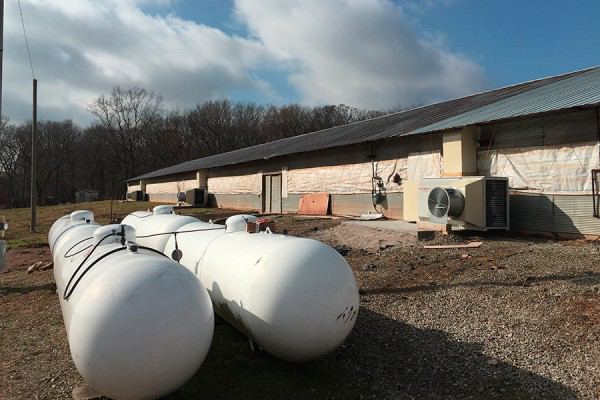Recycling heat economically in the poultry house

A waste heat recovery system to make heating of poultry barns more even, efficient and cost effective by driving down the amount of propane required to heat the barns in the winter, has been developed in the US.
Shawn Xu, an associate research professor of civil engineering at the University of Missouri was shocked to learn about the vast amounts of propane used to heat turkey and chicken facilities in a chance discussion with a poultry farmer in 2009. Having worked prolifically with ground source heat pumps and geothermal energy, he decided then and there to shift his focus to agriculture. He first devised a geothermal system for poultry farms, and now has turned his focus to waste heat recovery.
Strong ventilation in the barn
“I realised, there’s a strong ventilation in the barn, and that heating continues for 24 hours,” Xu said. “The inside of the barn’s 80, 90 degrees. If you stand in front of the fan, that’s warm air coming out of the barn. I said, ‘Why don’t we use that?'”
Xu — alongside his brother and research associate Tingsheng Xu, whom he credits for prototyping and field testing the system — developed a waste heat recovery system to make heating of poultry barns more efficient and more cost effective by driving down the amount of propane required to heat the barns in the winter. Unlike previous systems, Xu’s waste heat recovery system captures about 60% of the exiting warm air to pre-warm the incoming air, meaning the heaters don’t have to expend as much energy and use as much propane to heat the air in the barn. Depending on the type of bird and the birds’ ages, barns typically are kept anywhere from 65 to 90 degrees year-round.
“I started working with the University of Arkansas. We precisely figured out how much of the heat goes through your roof, losses through your wall, and how much is wasted through your ventilation,” Xu said. “About 80% goes through the ventilation. That really made me excited [about the possibilities of the new system].”
Field tests
Xu — along with co-investigators Tingsheng Xu and Robert Reed, an associate research professor of civil engineering — presented early findings from two types of barns at the Midwest Poultry Federation Convention, held in March in St. Paul, Minn. In the first test, Xu looked at two broiler barns in which eight heat recovery units were installed and compared them to two with conventional heating systems. After two years, his data showed propane savings of between 45 and 50% using the waste heat recovery units, with variations based on weather patterns and operations.
The second field test began operating at a turkey barn in December, 2014, Early on, however, Xu said the system helps eliminate a cold spot prevalent in turkey barns. Turkey barns use a drop curtain in place of a solid wall for proper ventilation, but air entering via loose fitting curtains can create pockets of cold spots, forcing the turkeys to congregate in a smaller area. Farmers often have to adjust the curtain day and night to avoid this.
Because the system is designed to run continuously, and variable speed drivers allow farmers to set the amount of fresh air needed, the system helps eliminate the need for constant adjustments by providing a more even temperature throughout the facility. The system also has a timed flushing system to remove the dust, feathers and other airborne items that can get trapped and clog the system.
USDA grant for further study
The USDA has granted further study of Xu’s preliminary hypothesis that the waste heat recovery system improves the air quality in the barns by lowering the amount of carbon dioxide, ammonia and moisture, as well as helping create bigger and healthier birds overall. Farmers in Missouri, Minnesota and Nebraska have committed to using the system for field testing, which also would be covered by the USDA grant.
Join 31,000+ subscribers
Subscribe to our newsletter to stay updated about all the need-to-know content in the poultry sector, three times a week. Beheer
Beheer








 WP Admin
WP Admin  Bewerk bericht
Bewerk bericht